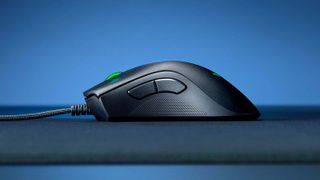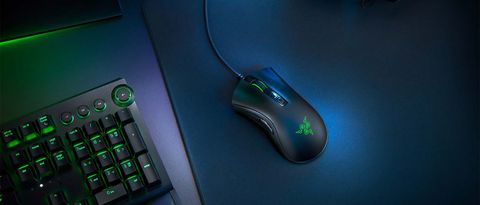Tom's Guide Verdict
The Razer DeathAdder V2 is a perfect example of everything that a gaming mouse should be, even if there's not much new.
Pros
- +
Comfortable design
- +
Smart button layout
- +
Excellent performance
- +
Better sensor and feet
Cons
- -
Almost identical to previous models
- -
Software can be convoluted
Why you can trust Tom's Guide
People misuse the word "epitome" all the time. They use it to mean "pinnacle" when, in fact, "embodiment" is a lot closer to the true definition. In that spirit, I contend that the Razer DeathAdder V2 ($70) is the epitome of gaming mice. It's simply a perfect example of everything that a gaming mouse should be — even though it's not necessarily the very best gaming mouse ever released.
The Razer DeathAdder has been out — in some way, shape or form — since 2006, and in that time, more than 10 million units have been sold. Like its predecessors, the DeathAdder V2 features an ergonomic shape, a conservative number of extra buttons, textured finger grips and pleasant RGB lighting. This time around, it also has feet that glide more easily, as well as a more sweat-resistant coating on its face.
There's not much working against the DeathAdder V2, save for slightly confusing software and the availability of more ambitious mice for the same price or less. Razer has refined an oldie but goodie, and it demonstrates why this mouse has been going strong for almost 15 years.
Razer DeathAdder V2 design
Let's all say it together: The DeathAdder V2 is an ergonomic, right-handed mouse with a high, curved profile; textured grips on each side; and four extra buttons. (Razer does make a left-handed DeathAdder, but it's based on an older design.) This time around, the material is more hydrophobic, making it easier to grasp during long play sessions. The gliding feet on the bottom of the mouse are also made of a new material that glides with less friction.

The button layout is pretty much the same as before. There's a right button, a left button and a clickable scroll wheel, as well as two thumb buttons in a small semicircle. The only big difference this time is that the two dots-per-inch (DPI) sensitivity buttons aren't connecting rectangles; they're two small squares about an eighth of an inch apart. This makes them easier to click, but it's potentially slower to switch between them. I like the new design better, but I could see preferences going either way.
Razer DeathAdder V2 features
One cool feature of the DeathAdder V2 is that you can now store up to five onboard profiles. This could come in handy for tournaments, LAN parties or any other situation where your regular computer isn't handy. Otherwise, it's very similar to previous DeathAdder models, with RGB lighting on the scroll wheel and a Razer logo on the palm rest.

To control this lighting, as well as other important mouse features, you'll need to use the Razer Synapse Software. This feature-rich program has plenty of options, particularly if you want to create your own lighting patterns or sync the mouse with Philips Hue smart light bulbs.
If you want to adjust lighting or reprogram buttons, using Synapse is pretty straightforward. If you want to create profiles for individual games or sync the mouse with other Razer gear, however, the process can be a little more complicated. Synapse has no fewer than eight tabs, each of which can have up to four submenus. It's a comprehensive program but not necessarily a simple one. It's much stabler than it used to be, so Razer deserves some credit for that.

The DeathAdder V2 also features a new Focus+ optical sensor, which can reach DPI levels of up to 20,000. You'll never need to set it that high, of course, but the sensor is also accurate and precise, even at lower DPIs.
Razer DeathAdder V2 performance
I ran the DeathAdder V2 through Overwatch, Age of Empires II: Definitive Edition, Thronebreaker: The Witcher Tales and World of Warcraft, and the device performed well for every genre. Assigning control groups to my army of Portuguese crossbowmen was just as simple as guiding Queen Meve on her quest through the Lyrian countryside. Reprogramming buttons was simple, as was shifting DPI on the fly.

Because of its onboard profiles and responsive sensor, I could also see the DeathAdder V2 being a good choice for tournament play. First-person-shooter aficionados might prefer a mouse with a "sniper" thumb button, while massively multiplayer online game enthusiasts might want a few more thumb buttons — but I didn't have any problems in either genre.
Razer DeathAdder V2 bottom line
After 14 years, it's hard to come up with new ways to describe the Razer DeathAdder. It's one of the most versatile and consistently good gaming mice on the market, and the V2 is no exception. For $10 more, you could get the top-of-the-line Logitech G502, and for $10 less, you could snag the slightly more specialized Corsair M65. But if the DeathAdder V2 has any deal breakers, I couldn't find them. Here's to another 14 years.
Marshall Honorof is a senior editor for Tom's Guide, overseeing the site's coverage of gaming hardware and software. He comes from a science writing background, having studied paleomammalogy, biological anthropology, and the history of science and technology. After hours, you can find him practicing taekwondo or doing deep dives on classic sci-fi.


